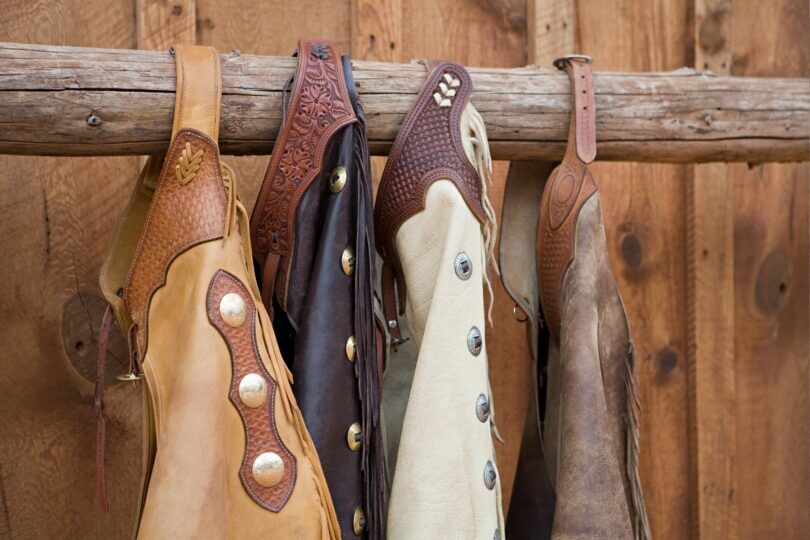Comparing Cowboy Couture
Curious about the difference between chaps and chinks? This post breaks down everything you need to know!
Chaps and chinks were both invented to protect cowboys’ legs from brush, cacti, and other work hazards. The biggest difference between the two has to do with their length.
Horse Riding Chaps
This cowboy wardrobe essential consists of two pieces of leather held together with a belt. The leather extends all the way from waist to toe.
History:
The use of leather to protect horses and riders from thick brush dates back to the 1600s. By the early 1800s, cowboys used loosely fitting leather held together with a belt over their pants as protection from cacti, brush, and cattle horns.
Over time, a few different types of chaps evolved.
One is the shotgun style, which has more of a straight leg shape. The second type, known as “batwings,” had a more flared appearance to provide more protection to the lower leg.
Last, “woolies” are chaps with fur to provide warmth in the winter.
Western Chaps. Photo Cred: Canva
Common Uses:
Working cowboys and ranchers use chaps to protect their legs from thorny brush and animal horns. Chaps also help the rider “stick” in the saddle better than jeans.
You’ll also find chaps in Western pleasure, horsemanship, and trail classes at horse shows.
In these environments, chaps are more about creating a polished and professional look than protection. Riders competing in reining also typically don chaps for competition.
Western Chaps. Photo Cred: Canva
Typical Materials:
Chaps were traditionally made of leather; however, today, you’ll find them made of suede and synthetic leather.
General Price Point:
You can find chaps for less than $75 or more than $500. The quality is often reflected in the price.
Horse Riding Chinks
This cowboy attire is similar to chaps, but shorter. Chinks typically extend from the waist to just below the knee. They may also have fringe.
History:
Chinks are likely descendants of the Spanish cowboy clothing called “armitas.” Loosely translated, “armita” means “little armor.” Chinks are made of slightly firmer leather than armitas, but have a similar shape.
The chink was often seen in California and Nevada. They were seldom seen in places like Texas until at least the 1990s.
Western Chinks. Photo Cred: Canva
Common Uses:
Branding or working with calves. They provide protection to the upper leg and knee while leaving the lower leg open.
You’ll often see chinks in ranch riding events instead of chaps.
Cowboys competing in a variety of rodeo events often sport chinks.
Farriers use chinks (without the decorative fringe) while trimming and shoeing to protect their legs.
Since chinks are shorter and cooler than chaps, you may see them more frequently in warmer climates.
Western Chinks. Photo Cred: Canva
Typical Materials:
Like chaps, you’ll find chinks made from leather, suede, and even synthetic materials. Leather is generally the most durable.
General Price Point:
Chinks retail for less than $75 on the low end and greater than $250 on the high end. Leather with tooling or other decoration can increase the price.
In general, the more you pay, the higher the quality and the longer the chinks will last.
Frequently Asked Questions
Q: What are the different kinds of chaps?
The two basic styles of chaps include shotgun and batwing. Shotgun chaps have a fitted look, while the batwing chaps have a slightly flared look.
Q: Is it pronounced chaps or shaps?
Either is technically correct, although many people strongly prefer “chaps.” The word “chaps” comes from “Chaparro,” a Spanish word that loosely translated means brush.
Want to hear it pronounced? Check out this short video:
Q: What are chinks for horses?
Before the invention of chaps and chinks for riders, leather pieces were attached to the saddle to protect both horse and rider. They were bulky and inconvenient, and the design was therefore abandoned.
Today, chinks are for the protection of the rider, not the horse.
Q: What type of leather is best for chaps?
Cowhide is most commonly used for chaps.
Q: What chaps do cowboys wear?
Cowboys generally wear leather chaps in either the shotgun or batwing style. Batwing chaps provide more protection to the lower leg but can be bulkier due to the extra leather at the bottom.
Chaps. Photo Cred: Canva
Parting Thoughts
For the last several centuries, chaps and chinks have played a vital role in a cowboy’s wardrobe. Even today, they continue to serve various purposes on ranches and in show rings around the country.
Although subtle, there are differences between chaps and chinks. And thanks to this post, you can confidently identify both chaps and chinks.
P.S. Enjoy this article? Trot on over to:
- 5 Comfy Tall Riding Boots That Look as Good as They Feel
- 3 Best
Dressage Boots for Horses Moving Up the Levels - 4 Dressage Fashion Trends & Salute-Worthy Styles
- Matt Harnacke Inside Scoop (Dressage, Horses, Fan Quiz)
- Matt Harnacke
Dressage Equestrian Vlog
